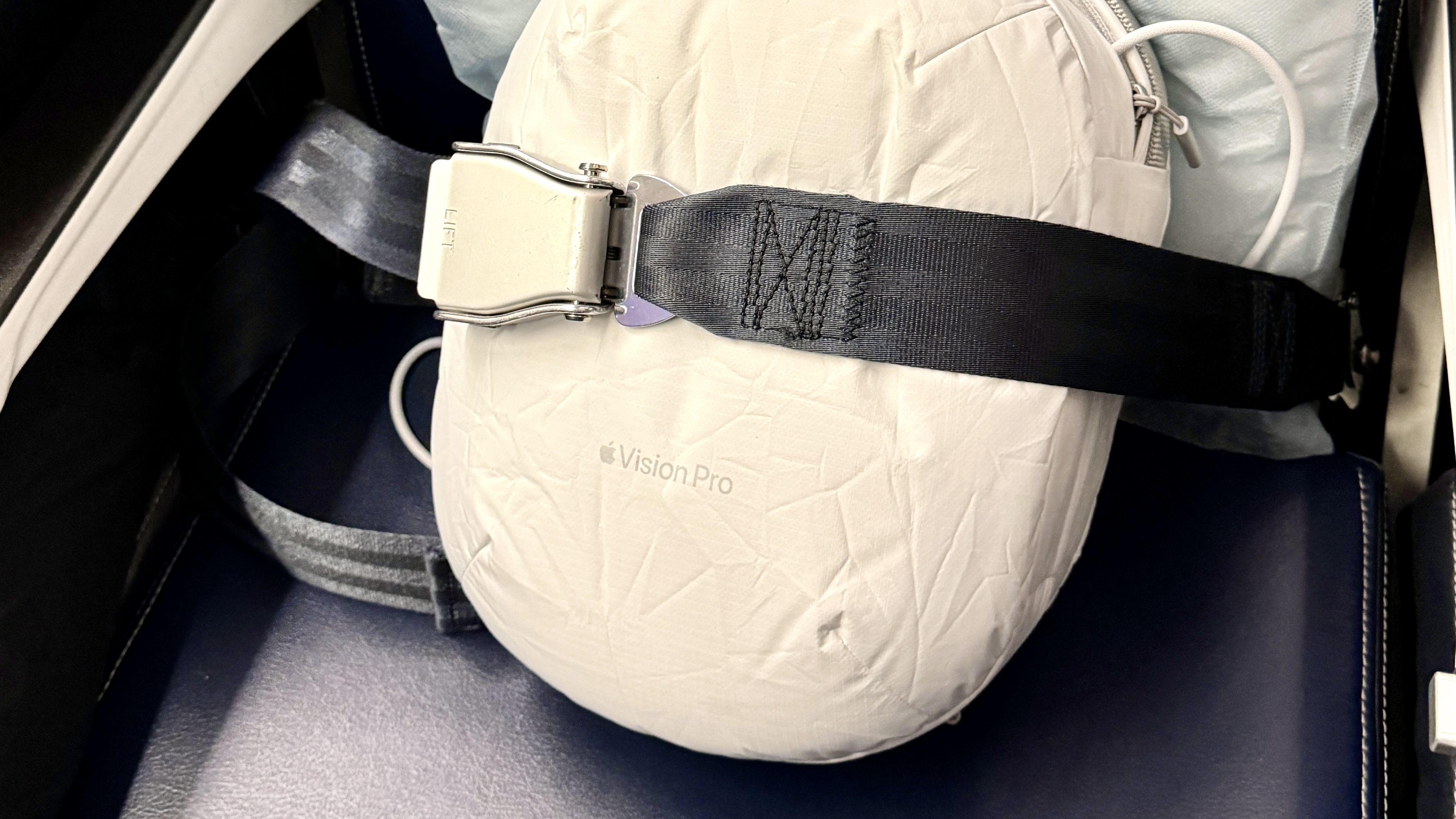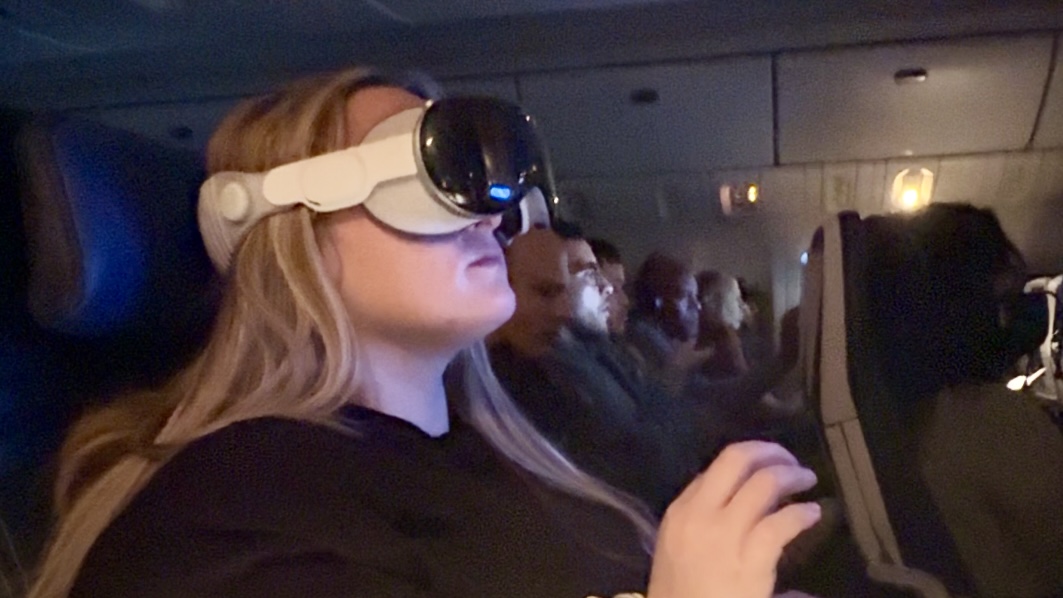I flew 8,000 miles wearing Apple Vision Pro — here's what it's really like
What I wish I knew before flying with Vision Pro

For someone who can’t stand airplanes, I take a ridiculous amount of flights. They’re cramped, kind of grimy, and being strapped into a cabin full of strangers can be terribly overstimulating. While I’ve tried dozens of methods to make flying more enjoyable, nothing has helped me chill the f–k out in the air as much as Apple Vision Pro.
Apple’s $3,500 mixed reality headset might sound like a pricey solution to flying anxiety, but I wanted to find out if it beats buying a business class ticket every trip for comfort’s sake. Booked in coach for a roundtrip journey from New York to Barcelona, I brought my Vision Pro along to gauge its true value as a travel companion.
As a result, I spent 8,000 miles and a majority of 14 hours wearing the spatial computer. While I found the headset successfully helped me escape from the common airplane nuisances, there are some things I wish I knew more about beforehand. They say you learn by doing, so let’s just say I did it for you — ’it’ being using Apple Vision Pro on a flight. Here’s what I think you can expect based on my experience.
It's important to pack smart
Compared to my iPad mini 6 or even my MacBook Air 15, packing the Vision Pro isn’t as simple as sliding it into my backpack. Determined to protect the Vision Pro from accidental damage, I concluded using a travel case is non-negotiable. I had Apple’s own Vision Pro Travel Case optimized for storing the headset safely, but at $199, it’s an expensive accessory. (Luckily, you can expect to see more reputable casemakers come out with comparable options for less now that the Vision Pro is available.)
Bundled up in the cloud-looking case, the Vision Pro is suddenly the size of a personal item. Depending on your ticket, you might need to be smart about how you pack. I was able to cram the case inside my backpack, though at the expense of the enormous snack stash I usually carry. I tucked some other items I keep in my backpack into pockets and my overheard bin suitcase.

It’s also important that you pack a USB-C charging cable and USB-C power adapter with your headset. Since the battery life is 2.5 hours for watching movies, and my flights were both much longer, I made sure to claim a power outlet and kept the battery pack plugged into the charger throughout the entire journey.
Travel Mode is non-negotiable
Once I was situated at my seat, I prepared myself and my headset for takeoff. I luckily had the middle seat open next to me for both flights, so I strapped the case in. Otherwise, I would’ve left it in my bag stowed under the seat in front of me until we were in the air. Apple advises waiting until the takeoff process is complete to use Vision Pro for safety purposes.
Sign up to get the BEST of Tom's Guide direct to your inbox.
Get instant access to breaking news, the hottest reviews, great deals and helpful tips.
You can’t necessarily use your Vision Pro on a moving plane the same way you would at home. Travel Mode for Apple Vision Pro is a setting that adapts and optimizes the headset specifically for use during flights. The moment I turned on my headset, it prompted me to enable Travel Mode, though you’re able to manually turn it on or off in the control center at any time. I tried turning it off just to see if it makes a difference, but this was a mistake. Without travel mode, every little bump or shake of the aircraft is as if it were in your eyeballs. It’s incredibly uncomfortable, so I’ll be sure to use Travel Mode going forward.
In-flight entertainment has been put to shame
What is someone to do with a VR headset and hours to pass? A movie marathon is the only right answer. Normally, I watch downloaded TV shows on my iPad mini in the air, but the 8.3-inch screen isn’t exactly great for blockbuster films. But now that I had Vision Pro, I could watch all my favorite movies on the equivalent of a 100-foot-wide screen.
There are some major streaming apps still missing from the visionOS catalog, but between Disney Plus, Apple TV, and Max, I had no shortage of content. I spent a majority of my flights captivated by 3D-rendered versions of the Star Wars sequel trilogy. Being able to watch these films in stunning detail, certain scenes touched me in ways I didn’t even feel at the movie theater. When Finn and Poe Dameron reunite at the rebel base after presuming one another dead, I broke into tears, which my Vision Pro’s light seal subsequently soaked up.
The best part, however, was watching these movies in Disney Plus’s built-in Environments. After viewing all the action from a speeder on Tatooine, I don’t think I can watch Star Wars any other way. But more importantly, I felt completely detached from being on an airplane. With the Environment completely dialed in, and my AirPods Pro 2 blocking out sound, I just as well could’ve been sitting at my own desk at home. For a few hours at a time, I forgot I was on a plane, and it was magical.
Not made for red-eyes
One of my legs for this trip took off in the evening in New York and landed in Barcelona in the morning. Commonly referred to as a red-eye, these kinds of overnight flights are set up to help you get a few hours of sleep before a full day ahead at your destination. If sleeping as much as possible on your flight is your goal, I’d recommend leaving the Apple Vision Pro at home.
For one, it’s not really possible to get sleep-level comfortable while wearing the Vision Pro — at least not in a mostly up-right seat. The weight of the headset is alleviated by swapping to the Dual Loop Band, but it’s still very much obvious that there’s something strapped to your face. Plus, when I tried snuggling up against a window, I blocked one side of the headset’s cameras, causing my movie to pause. This is a necessary safety feature, but also an affirmation that it’s not practical to use the Vision Pro when you’re trying to get some quality rest.
Flying with Apple Vision Pro: Would I do it again?

So, as long as I’m not taking a red-eye, the Vision Pro is coming along with me on flights for the foreseeable future. Now that I learned what to expect from a packing perspective and am familiar with Travel Mode, I feel like an expert in traveling with Apple’s headset.
The one thing that would make it better is if I had a few more streaming apps to access. Don’t get me wrong, I can watch the entire Star Wars catalog on repeat and never get sick of it. But a larger quantity of options would enhance the quality of the entire experience. Hopefully apps like Netflix and Hulu will come to visionOS not too far down the line, making the Vision Pro more valuable overall. In the meantime, the ability to tune the rest of the cabin out with a turn of the digital crown is — if you ask me — priceless.
More from Tom's Guide
Kate Kozuch is the managing editor of social and video at Tom’s Guide. She writes about smartwatches, TVs, audio devices, and some cooking appliances, too. Kate appears on Fox News to talk tech trends and runs the Tom's Guide TikTok account, which you should be following if you don't already. When she’s not filming tech videos, you can find her taking up a new sport, mastering the NYT Crossword or channeling her inner celebrity chef.
-
Jeffb6 The only thing missing is the reminder to turn on the Travel feature before the plane moves. Turning on after it moves is hard. But highly necessary as the plane keeps moving through the stationary screen.Reply -
themac1977 So, basically you paid almost 10 x the price to do what people have been able to do with other VR headsets for the last several years?Reply -
glideconsultant Thx for a nice, well written and informative article.Reply
One question:
How did you store those movies on the VP and how m would you need for a 2h-4k-3d-movie, until you run out of (how much?) internal storage?
(you most likely were not online all the time, weren't you ?)
TIA for your reply.

